#neutron star
Text
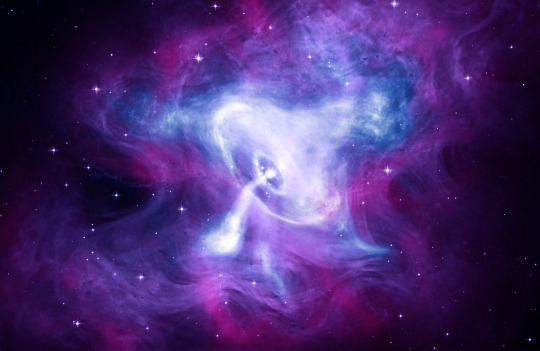
Navigating Deep Space by Starlight
On August 6, 1967, astrophysicist Jocelyn Bell Burnell noticed a blip in her radio telescope data. And then another. Eventually, Bell Burnell figured out that these blips, or pulses, were not from people or machines.

The blips were constant. There was something in space that was pulsing in a regular pattern, and Bell Burnell figured out that it was a pulsar: a rapidly spinning neutron star emitting beams of light. Neutron stars are superdense objects created when a massive star dies. Not only are they dense, but neutron stars can also spin really fast! Every star we observe spins, and due to a property called angular momentum, as a collapsing star gets smaller and denser, it spins faster. It’s like how ice skaters spin faster as they bring their arms closer to their bodies and make the space that they take up smaller.
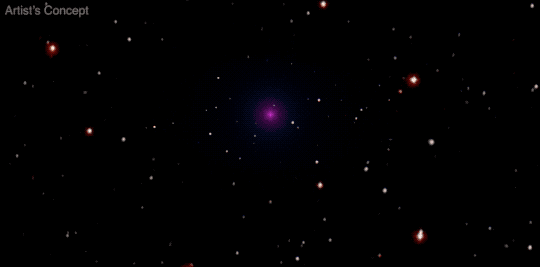
The pulses of light coming from these whirling stars are like the beacons spinning at the tops of lighthouses that help sailors safely approach the shore. As the pulsar spins, beams of radio waves (and other types of light) are swept out into the universe with each turn. The light appears and disappears from our view each time the star rotates.

After decades of studying pulsars, astronomers wondered—could they serve as cosmic beacons to help future space explorers navigate the universe? To see if it could work, scientists needed to do some testing!
First, it was important to gather more data. NASA’s NICER, or Neutron star Interior Composition Explorer, is a telescope that was installed aboard the International Space Station in 2017. Its goal is to find out things about neutron stars like their sizes and densities, using an array of 56 special X-ray concentrators and sensitive detectors to capture and measure pulsars’ light.

But how can we use these X-ray pulses as navigational tools? Enter SEXTANT, or Station Explorer for X-ray Timing and Navigation Technology. If NICER was your phone, SEXTANT would be like an app on it.
During the first few years of NICER’s observations, SEXTANT created an on-board navigation system using NICER’s pulsar data. It worked by measuring the consistent timing between each pulsar’s pulses to map a set of cosmic beacons.
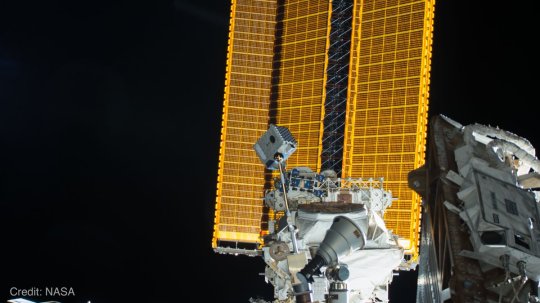
When calculating position or location, extremely accurate timekeeping is essential. We usually rely on atomic clocks, which use the predictable fluctuations of atoms to tick away the seconds. These atomic clocks can be located on the ground or in space, like the ones on GPS satellites. However, our GPS system only works on or close to Earth, and onboard atomic clocks can be expensive and heavy. Using pulsar observations instead could give us free and reliable “clocks” for navigation. During its experiment, SEXTANT was able to successfully determine the space station’s orbital position!
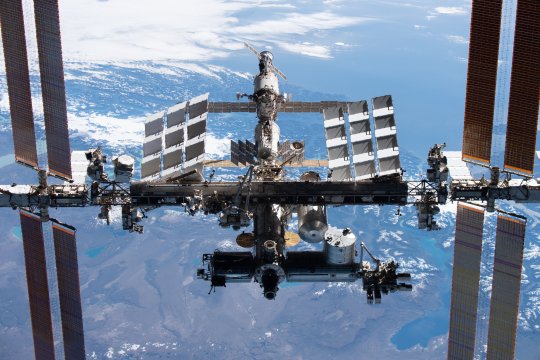
We can calculate distances using the time taken for a signal to travel between two objects to determine a spacecraft’s approximate location relative to those objects. However, we would need to observe more pulsars to pinpoint a more exact location of a spacecraft. As SEXTANT gathered signals from multiple pulsars, it could more accurately derive its position in space.
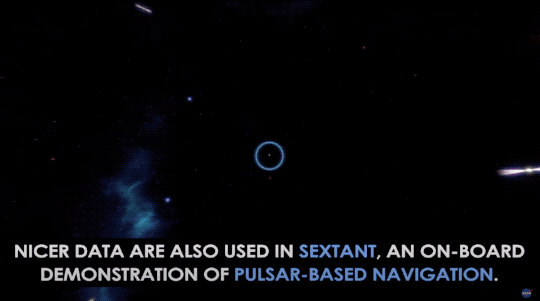
So, imagine you are an astronaut on a lengthy journey to the outer solar system. You could use the technology developed by SEXTANT to help plot your course. Since pulsars are reliable and consistent in their spins, you wouldn’t need Wi-Fi or cell service to figure out where you were in relation to your destination. The pulsar-based navigation data could even help you figure out your ETA!
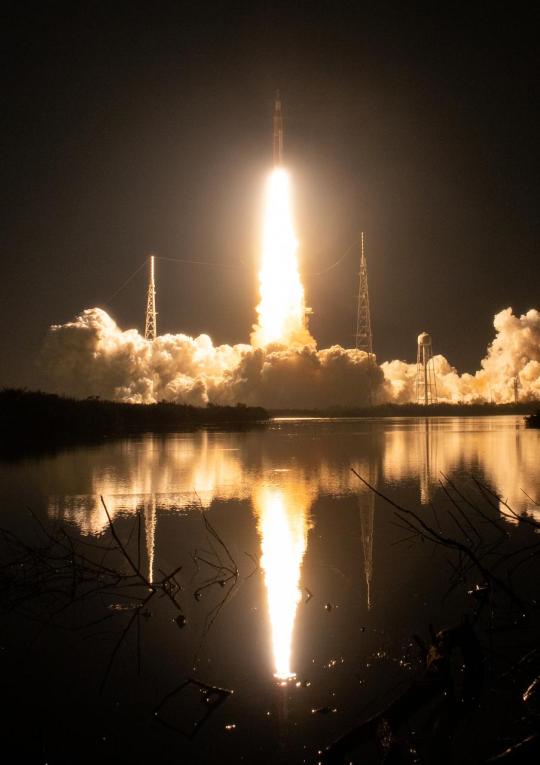
None of these missions or experiments would be possible without Jocelyn Bell Burnell’s keen eye for an odd spot in her radio data decades ago, which set the stage for the idea to use spinning neutron stars as a celestial GPS. Her contribution to the field of astrophysics laid the groundwork for research benefitting the people of the future, who yearn to sail amongst the stars.
Keep up with the latest NICER news by following NASA Universe on X and Facebook and check out the mission’s website. For more on space navigation, follow @NASASCaN on X or visit NASA’s Space Communications and Navigation website.
Make sure to follow us on Tumblr for your regular dose of space!
#NASA#pulsar#Jocelyn Bell Burnell#spaceblr#space#star#neutron star#deep space#telescope#navigation#universe#astronomy#science
4K notes
·
View notes
Text
Y'all, I'm getting emotional.
One of my absolute favorite astronomical bodies is the Crab Nebula, or Messier 1. The Crab Nebula is a "planetary nebula", which means it's the enormous, beautiful corpse of a once-giant star. The star that formed the Crab Nebula went supernova and exploded in 1054, and was so bright at the time of its death that you could see it from Earth during the day - for almost a month. For that month, it was brighter than every single thing in the sky except the moon and the sun. Some of you have probably heard of it, or have at least seen this Hubble picture:

But how many of y'all have zoomed in?
Inside all of those lovely rainbow clouds is the supernova remnant - a neutron star. A neutron star is made of the densest possible material that we know of - any denser, and it'd collapse the rest of the way into a full-fledged black hole. Neutron stars are so unimaginably dense that they're not even made of an element, not really. The star at the center of the Crab Nebula is one, single atomic nucleus 12 miles in diameter, made entirely of close-packed neutrons. One teaspoon would weigh 10 million tons. Imagine taking a passenger jet, condensing it down to the size of a mote of dust, and then filling a spoon with that dust. And it spins too - 30 times a second. That spinning causes huge jets of material to eject from the poles at half the speed of light. The incredibly powerful magnetic field traps any stray particles and accelerates them in circular paths through the nebula. Just LOOK at this shit! See the ghosty shadows of the jets, stretching from the top left corner to the bottom right?

But what's really making me lose it is this Hubble timelapse. The star is making ripples. Its moving. Its been dead for almost a thousand years, but its still putting on its final, spectacular show.
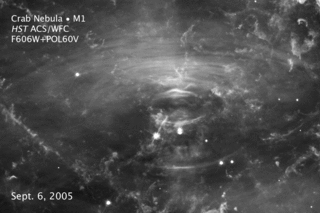
It never ceases to amaze me that the things we call "dead" stars are some of the most dynamic, energetic, and awe-inspiring objects in the universe. Normal stars are downright STAGNANT compared to what these so-called "stellar remnants" get up to. Maybe we shouldn't be thinking of them as dead stars, but as the next phase in a star's life. Just as caterpillars "end" their mundane lives and metamorphose into something new and strange and capable of flight, these stars destroy themselves to leave behind something far more exotic, playing at the edge of the laws of physics in ways we still don't fully understand.
#space#crab nebula#neutron star#supernova#god I fucking love neutron stars#ask me sometime about the first pulsar#hubble#spost#space post
738 notes
·
View notes
Text
There's something strange on the outskirts of the Milky Way.
In a cluster of stars skimming the outer reaches of the galaxy, astronomers have identified something very small, and very dense, locked in an orbital dance with a millisecond pulsar. There are, they say, only two things the mystery object could be – a neutron star or a black hole – but either one of those things would be an exciting find.
If it's a neutron star, it could be the heaviest of its kind we've ever seen. If it's a black hole, it's the lightest of its kind.
Continue Reading.
100 notes
·
View notes
Text
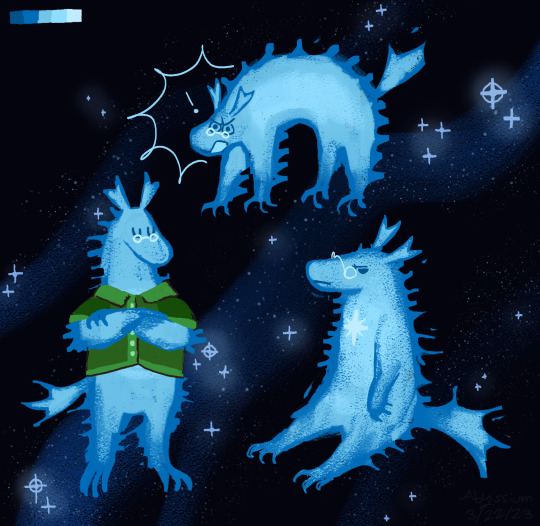
neutron star
#oc#oc: newton#<- sounds similar to neutron hehe#i want to make more stars just need to figure out designs and personalities. maybe a quasi-star next. who knows#space#star#stars#neutron star#doodle#art#digital art#the shirt is just an example of wht kind of clothes it wears it doesnt always wear just that shirt when it is wearing clothes
450 notes
·
View notes
Photo
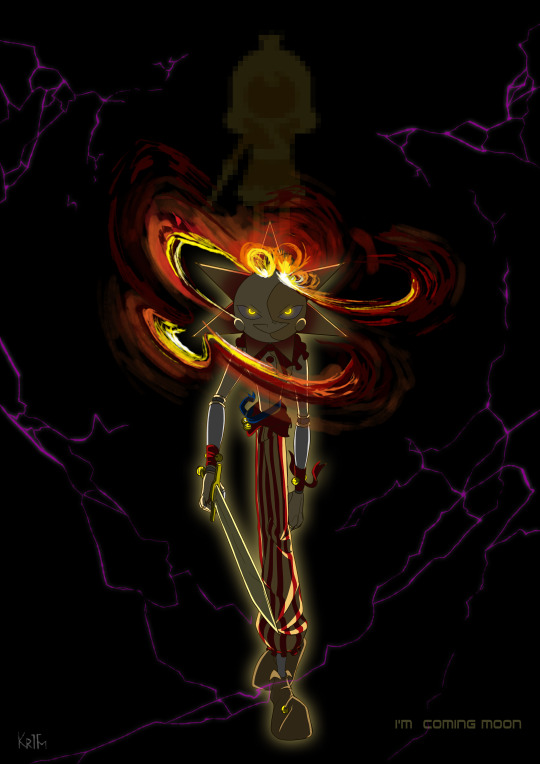
Solar Knight
Speed draw here!
#fnaf#fnafsundrop#do you really want to piss him off?#solarflare#he's going to save Moon#you. can't. stop him.#ngl i'm into these flares#FNAFDailyDaycare#AU#when a sun reaches a critical temperature it starts to change#red giant#neutron star#BLACK HOLE?!
723 notes
·
View notes
Link
Neutron stars are some of the most extreme phenomena in the entire universe, and new discoveries about these dense stellar corpses continue to surprise scientists.
Astronomers recently announced the discovery of a magnetized neutron star which seems to have an entirely solid surface. Stars are typically made of hot orbs of plasma, which is a type of ionized gas; while neutron stars are, owing to their incredible density, typically undulations of supercompressed solid matter (mostly neutrons) with a core that is a type of frictionless fluid called a superfluid.
They often have atmospheres, like Earth, too. The idea of a neutron star that is completely solid, akin to a super dense planet with no atmosphere, is pretty unique.
Reporting in the journal Science, an international team of 50 researchers used data from the Imaging X-ray Polarimetry Explorer (IXPE), a satellite launched in December 2021 by NASA and the Italian Space Agency.
The astronomers pulled info on the obliquely named neutron star 4U 0142+61. It's a special type of neutron star, called a magnetar, located approximately 13,000 lightyears from Earth in the constellation Cassiopeia...
269 notes
·
View notes
Photo



The first rendition of these two Collector characters!
The Neutron Star (she/they) I imagine like a matron-esque figure.
The White Dwarf (they/it) would be even younger than The Collector and a bit of a tattletale.
Hopefully I can develop these two more in the future!
330 notes
·
View notes
Text

#heartbreak#heartbroken#sad poem#saddness#poetry#neutron star#love quotes#heart ache#weight of the world#rosemerry wahtola trommer#frienship#friends#empathy#grief poetry#coping with grief#dealing with grief#grief poem#tenderness
341 notes
·
View notes
Text


Happy 56th anniversary of the observation of pulsars!
On 28 November 1967, while a postgraduate student at Cambridge, Bell Burnell detected a "bit of scruff" on her chart-recorder papers that tracked across the sky with the stars. The signal had been visible in data taken in August, but as the papers had to be checked by hand, it took her three months to find it.[25] She established that the signal was pulsing with great regularity, at a rate of about one pulse every one and a third seconds. Temporarily dubbed "Little Green Man 1" (LGM-1) the source (now known as PSR B1919+21) was identified after several years as a rapidly rotating neutron star.
Nice Q&A with Professor Dame Jocelyn Bell Burnell: https://www.cam.ac.uk/stories/journeysofdiscovery-pulsars
3D art featuring pulsars by me; info:
https://www.olenashmahalo.com/project/nanograv
#sciart#3d#illustration#science illustration#physics#astronomy#astrophysics#3d art#art#published#portfolio#olena shmahalo#natureintheory#pulsars#pulsar#AGN#neutron star#blazar#quasar#women in stem#women in STEAM#women in science#women in art
26 notes
·
View notes
Video
Neutron Stars: Pulsars
PULSARS are rapidly rotating NEUTRON STARS that blast out pulses of radiation at regular intervals ranging from seconds to milliseconds.
Pulsars have strong magnetic fields that funnel particles along their magnetic poles accelerating them to relativistic speeds, which produces two powerful beams of light, one from each pole.
Like all neutron stars, pulsars have quite tightly constrained masses and sizes, most neutron stars have a mass of around 1.5 times that of the sun. One respect in which pulsars vary a lot is their rate of rotation. Some spin at a rate of hundreds of times per second, which NASA says(opens in new tab) is faster than the blades of a household blender.
In 2022 astronomers discovered the heaviest neutron star to date with a mass of 2.35 times that of the sun, which is also the fastest-rotating pulsar ever found in the Milky Way. The pulsar designated PSR J0952−0607 is also known as the Black Widow pulsar as it is believed to have reached record-breaking rotational speed and mass by consuming a companion binary star.
The Black Widow pulsar rotates at 707 Hertz (HZ), or 707 times per second. This is topped by the pulsar PSR J1748–2446ad which rotates at 716 HZ or 716 times per second.
Music: Gvozdini - Pasadena
Animation : Melodysheep
Via astroospace
#space#planets#earth#moon#solar system#Galaxies#pulsar#neutron star#universe#gravity#quantumphysics#loopquantumgravity#quantummechanics#quantumtheory#Space Exploration#reels#4K#8K#aesthetics#wanderlust#explore#follow#discover
116 notes
·
View notes
Text
I just realized that our mf sacrificial bastard mc Cale-I'm-trash-but-always-does-the-opposite-of-trash-Henituse and us readers have a very very weird type of relationship like we want to baby him and smother him with love as much as possible and spoil him with fluffy family fanarts or fics like him resting or going in an outing he's fine with the kids and other characters to the point our fanbase weather forcast will become Cloud9 with a chance of Cavities and Fluff but will always insult him for his denser than a fucking neutron star brain that turned off recognizing love related emotions and advances and be the next densest material of all dimensions but also an airhead most of the time like fucking hell they're showing you famial love and tryna take care of you you stupid fuck and our weather forcast is CloudWhy with a chance of You, So and Dense but will also vibrate in our chairs/beds/bathroom/sofa/basement/couches whenever he does something badass or looks badass and be awesome and cool and holy shit oh my god its here lets fucking go and our weather forcast is CloudLETSGO with a chance of HESSOCOOL and WHOOOO but will also dreadfully look forward to him coughing up blood and him fainting and even make fanarts and way over the angst fics and our weather forcast is CloudsofPain with a chance of AAAAAA and AAAAAAAA and Cale and us getting angst slapped and we readers will equally and gladly devour and savor muah chiefs kiss it like wtf yall good
#tcf#trash of the count's family#cale henituse#yall good fr?#lcf#lout of the count’s family#neutron star#cuz its ther#typed this while washing rice how we doin#dense character#dense fictional character#definitely did not search what the most densest material in the universe is fuck you#i thought it was a blackhole had to fact check it for a sec#i just realized that was contradictory as fuck ignore that statement
289 notes
·
View notes
Photo

Colliding Neutron Stars l NASA
l Detected in 2017, it had actually happened 130 million years earlier.
#nasa#universe#space#Astronomy#astrophotography#neutron star#stars#galaxy#planets#solar system#tags dont work
447 notes
·
View notes
Text
2024 March 25
Sonified: The Jellyfish Nebula Supernova Remnant
Image Credit: X-ray (blue): Chandra (NASA) & ROSAT (ESA); Optical (red): DSS (NSF); Radio (green): VLA (NRAO, NSF); Sonification: NASA, CXC, SAO, K. Arcand; SYSTEM Sounds: M. Russo, A. Santaguida)
Explanation: What does a supernova remnant sound like? Although sound is a compression wave in matter and does not carry into empty space, interpretive sound can help listeners appreciate and understand a visual image of a supernova remnant in a new way. Recently, the Jellyfish Nebula (IC 443) has been sonified quite creatively. In the featured sound-enhanced video, when an imaginary line passes over a star, the sound of a drop falling into water is played, a sound particularly relevant to the nebula's aquatic namesake. Additionally, when the descending line crosses gas that glows red, a low tone is played, while green sounds a middle tone, and blue produces a tone with a relatively high pitch. Light from the supernova that created the Jellyfish Nebula left approximately 35,000 years ago, when humanity was in the stone age. The nebula will slowly disperse over the next million years, although the explosion also created a dense neutron star which will remain indefinitely.
#astronaut#astronomers#not astrology#star#stars#art#astronomy#outer space#space#artist#NASA#Nebula#Supernova#remnant#aquatic#jellyfish#neutron star#Jellyfish nebula
8 notes
·
View notes
Link
A flash of light emitted by colliding neutron stars has once again upended our understanding of how the Universe works.
Analysis of the short gamma-ray burst spat out as the two stars merged revealed that, rather than forming a black hole, as expected, the immediate product of the merger was a highly magnetized neutron star far heavier than the estimated maximum neutron star mass.
This magnetar seems to have persisted for over a day before collapsing down into a black hole.
"Such a massive neutron star with a long life expectancy is not normally thought to be possible," astronomer Nuria Jordana-Mitjans of the University of Bath in the UK told The Guardian. "It is a mystery why this one was so long-lived."
Continue Reading.
280 notes
·
View notes
Text
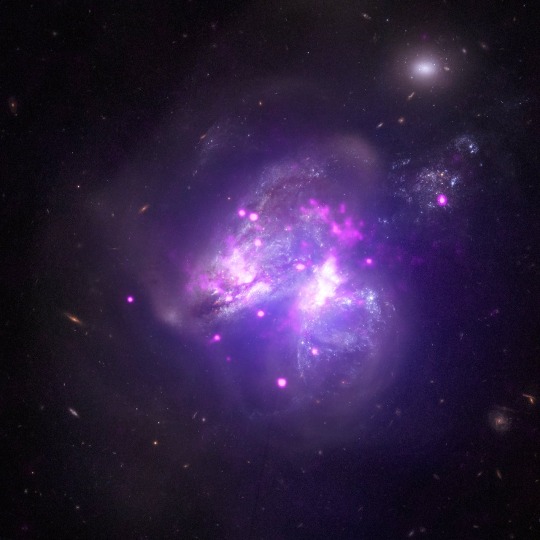
💫 “Today Chandra is studying a Black Hole in Ursa Major. Nearby in the sky two galaxies are merging in Arp 299. At least 14 "ultra-luminous X-ray sources" (ULXs) have been discovered here. All are likely black holes or neutron stars pulling material from a companion star.”
source . more from chandra x-ray observatory .
#space#chandra#chandra observatory#chandra x ray observatory#nasa#outer space#black hole#Ursa Major#constellations#neutron stars#stars#neutron star#galaxy#galaxies#space photography#astronomy
93 notes
·
View notes
Text
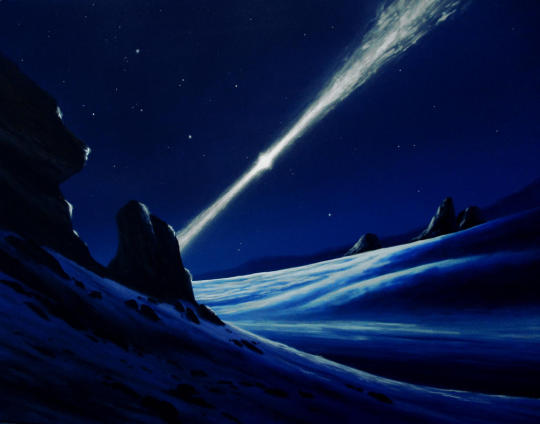
"Pulsar Planet I" by Axel Juárez.
14 notes
·
View notes